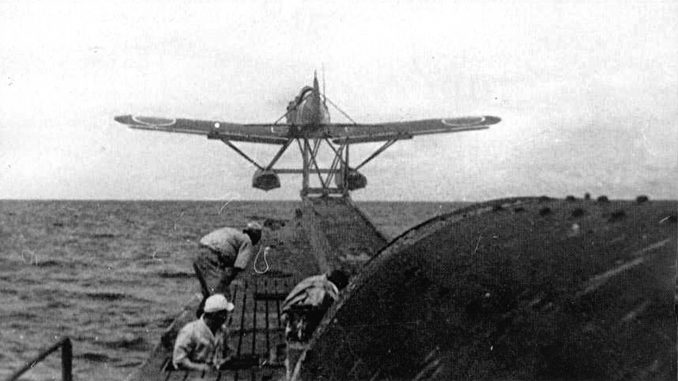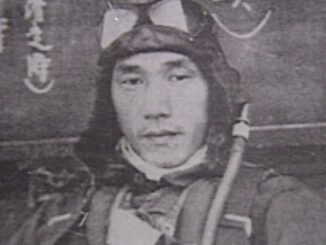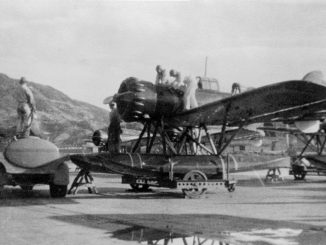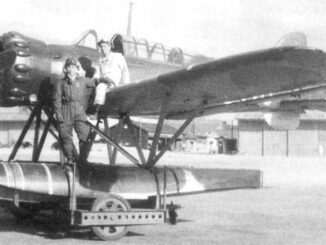
In 1937 the Osaka Mercantile Steamship line ordered three fast ocean liners for its routes to Africa. The Imperial Japanese Navy, cognizant of the worsening political situation and in the expectation of future wars, insisted that these ships be designed with features which would facilitate their conversion into armed merchant cruisers. Three ships were built – Hokoku Maru, Aikoku Maru and Gokoku Maru. All were fast, having a top speed of 21 knots, and had mounts for up to eight 6-inch guns as well as anti-aircraft weapons and torpedoes. Only the Hokoku Maru actually entered civilian service, albeit for a brief period – the others were requisitioned by the Navy soon after they were completed. A fourth ship of an older design, Kiyozumi Maru, was also requisitioned.
All four ships were planned to be added to the 24th Cruiser Squadron and deployed for commerce raiding in the eastern Pacific, but in the end only two were used in this capacity. Hokoku Maru and Aikoku Maru were the first to complete conversion, being fitted with eight 5.9-inch guns, four torpedo tubes, two or four anti-aircraft guns, searchlights, and facilities for a pair of E7K Type 94 floatplanes. The other two ships were still being converted when the war broke out, and were destined never to serve as merchant cruisers. Hokoku Maru and Aikoku Maru were sent to Jaluit in the Marshall Islands prior to the outbreak of hostilities, and from there set out to prey on Allied shipping in the lanes between the US and Australia.
The first victim of the raiders was the steamship Vincent, which was carrying a cargo of rice from Australia to Panama. The ship was sighted on the 13th of December, and was ordered to heave-to but not before she transmitted a distress message. The crew was ordered to abandon ship, and Vincent was sunk by shellfire. The crew were taken aboard as prisoners. A few weeks later, an E7K from Aikoku Maru spotted the freighter Malama heading for the Philippines, radioed a position report, and then vanished without trace. A second floatplane failed to find the first, but re-acquired contact with the Malama on the 2nd of January, near the Cook Islands. The aircraft strafed the freighter and forced her to stop, before the crew set scuttling charges and abandoned ship. The E7K then dropped four small bombs on the Malama, starting a fire, and the ship finally sank. The survivors were soon picked up and thereafter the cruisers returned to Japan, having sunk less than 10,000 tons of shipping.
Indian Ocean Submarine Offensive
Unimpressed with these modest results, the Navy decided to convert the cruisers into auxiliary submarine tenders. They were provided with stowage areas for submarine spare parts and torpedoes and fuel tanks for diesel fuel, and then dispatched to Penang in newly captured Malaya. Here they also swapped their E7Ks for newer and more capable E13A Type 0s. The 24th Cruiser Division was disbanded and Hokoku Maru and Aikoku Maru were attached to the 8th Submarine Squadron, which was at this time operating in the Indian Ocean in support of an offensive sweep to Ceylon by the Kido Butai.
The twin cruisers arrived at Penang in late April, in time to join the rest of the 8th Submarine Division in an attack on the island of Madagascar. This island was invaded by the British on the 5th of May, and on the same day Hokoku Maru and Aikoku Maru departed for a raiding cruise in the Indian Ocean in company with five I-boats. These ships made up the Western Attack Unit, a counterpart to the Eastern Attack Unit that was to conduct a simultaneous attack on Sydney, Australia. Three of the submarines – I-16, I-18 and I-20 – carried midget subs for an attack on Diego Suarez harbour, whilst two more – I-10 and I-30 – carried E14Y seaplanes with the intention of reconnoitring various locations on the west coast of Africa. En route to Madagascar, Aikoku Maru captured the Dutch tanker Genota.
I-30 departed for her patrol area first. She arrived off the Horn of Africa in early May, and launched her E14Y for a flight over the port of Aden, in modern-day Yemen, on the 7th of May. The following night the same aircraft flew over the Vichy port of Djibouti in French Somaliland, but came under fire from the various warships in the harbour and aborted the mission without gathering any useful intelligence. Eleven days later the submarine was off Tanganyika, and her aircraft overflew Dar-es-Salaam and nearby Zanzibar island, sighting a pair of merchant ships. I-30 herself then carried out a periscope examination of Mombasa in Kenya, whilst I-10 was busy launching her own E14Y to take a look at Durban, South Africa. This aircraft was spotted and challenged by Morse lamp, but the observer replied with a fake response and the aircraft escaped unharmed.
These reconnaissance missions confirmed that there were no worthwhile targets except for those supporting the British occupation of Madagascar. Accordingly the 8th Submarine Squadron converged on Diego Suarez in late May. On the 29th, I-10 launched her E14Y for an overflight of the harbour. The aircraft spotted a wealth of targets – the battleship Ramillies, a pair of destroyers, and several auxiliary ships. The British spotted the Japanese aircraft and Ramillies got underway amidst an alert, but she later anchored in a different berth. Two nights later, I-16 and I-20 launched their midget submarines, one of which soon penetrated the British defences. Ramillies was torpedoed and badly damaged, as was the tanker British Loyalty, which settled on the shallow bottom but was later refloated. One midget was lost with both crew members, but the second beached and the crew attempted to reach a designated retrieval point. However, the crew was found by a squad of Royal Marines and both were killed. A second flight by I-10’s E14Y failed to spot any sign of the midget crews, and the submarines were released to attack shipping.
Over next two months the ships of the 8th Submarine Squadron terrorised the western Indian Ocean. Aikoku Maru sank the merchant Elysia and then combined with her sister Hokoku Maru to capture the New Zealand ship Hauraki, which was sent back to Japan as a prize. The submarines combined to sink a total of 22 ships totalling over 100,000 tons, there being no convoy system in place for the shipping lanes on the east coast of Africa. The merchant cruisers were used to refuel the submarines to extend their time on station, as well as contributing to the losses of Allied shipping.
The Yanagi Missions
One of the submarines was given a special mission. Since Japan had joined the Tripartite Act which created the ‘Axis’, both the Japanese and the Germans had been keen to establish a route for the exchange of strategic minerals, technology and weapons. Surface raiders and blockade runners were increasingly vulnerable to Allied sea and air power, so the decision was made to attempt the voyage in a long-range submarine. I-30 was to make the first attempt at what the Japanese called ‘Yanagi’ missions. On the 18th of June, she refuelled from Aikoku Maru and then set sail for France under a blanket of radio silence. She was carrying a cargo of mica and shellac, and blueprints for the Type 91 aerial torpedo, as well as her E14Y. Evading South African air patrols, I-30 rounded the Cape of Good Hope at the end of June and headed north. The rest of the voyage was uneventful and I-30 met her escort of patrol planes and minesweepers, which guided her into Lorient on the 5th of August.
The crew was feted by their hosts, with the officers being flown to Berlin to meet Adolf Hitler himself. The Germans meanwhile prepared a cargo to be loaded onto I-30 for the return trip. Her E14Y was offloaded, with Luftwaffe markings applied over the distinctive Hinomaru. The aircraft was left behind so that the hangar space could be used for the precious cargo, which included a Würzburg fire-control radar set, electric submarine torpedoes, torpedo data computers and no less than 50 Enigma encryption machines. The Germans also provided I-30 with a Metox radar warning receiver, which would alert the crew if an aircraft with ASV radar was nearby, and a quad-20mm anti-aircraft battery. I-30 departed from Lorient on August 22nd successfully returned to Penang in October, only to hit a British mine and sink off Singapore. Much of the cargo was recovered but the Würzburg and many blueprints were destroyed.
Meanwhile the cruisers Hokoku Maru and Aikoku Maru had returned to Penang. After a brief refit at Singapore to increase stowage space for submarine torpedoes, the two former liners were attached to the Southwest Area Fleet and used to transport an Army infantry division to Rabaul, from where it was deployed to Guadalcanal. This duty completed, both ships returned to Penang once more in October. They departed in early November to resume duty as commerce raiders, entering the Indian Ocean once more on the 7th.
A few days later Hokoku Maru and Aikoku Maru came across the Dutch tanker Ondina, which was sailing from Fremantle to the Persian Gulf, escorted by the corvette HMIS Bengal. The Allied ships were badly outgunned, Ondina being equipped with a single 4-inch gun and Bengal a single 3-inch. Hokoku Maru was leading and engaged the Allied ships, which responded with their meagre armament. However luck was with them, as a lucky hit was scored on Hokoku Maru’s torpedo room, detonating one of the weapons. A fire started, and shortly afterwards her magazine exploded, which blew out her sides and caused her to rapidly sink. Aikoku Maru then arrived and took Bengal under fire, but the corvette escaped after depleting her ammunition. Aikoku Maru raked Ondina with fire, killing her captain, and fired three torpedoes which all missed. Ondina nevertheless looked doomed and so Aikoku Maru collected the survivors from her sister ship before heading back to Penang. Ondina’s crew were able to repair the ship sufficiently for her to return to Fremantle.
This abortive cruise proved to be the last commerce raiding mission undertaken by Japanese auxiliary cruisers. The three remaining ships of the former 24th Cruiser Squadron were instead used as fast transports or troopships. Aikoku Maru was converted into a transport, and had a relatively undistinguished career carrying troops to various locations in the Pacific. On 17th February 1944, the ship was moored in Truk lagoon when the American Task Force 58 struck. Aikoku Maru was hit by a single air-dropped torpedo and was destroyed when her cargo of ammunition exploded. Kiyozumi Maru was sunk the same day, having taken refuge at Truk after being damaged by an American submarine. Gokoku Maru was sunk near Formosa in November 1944 by the American submarine Barb.




Leave a Reply